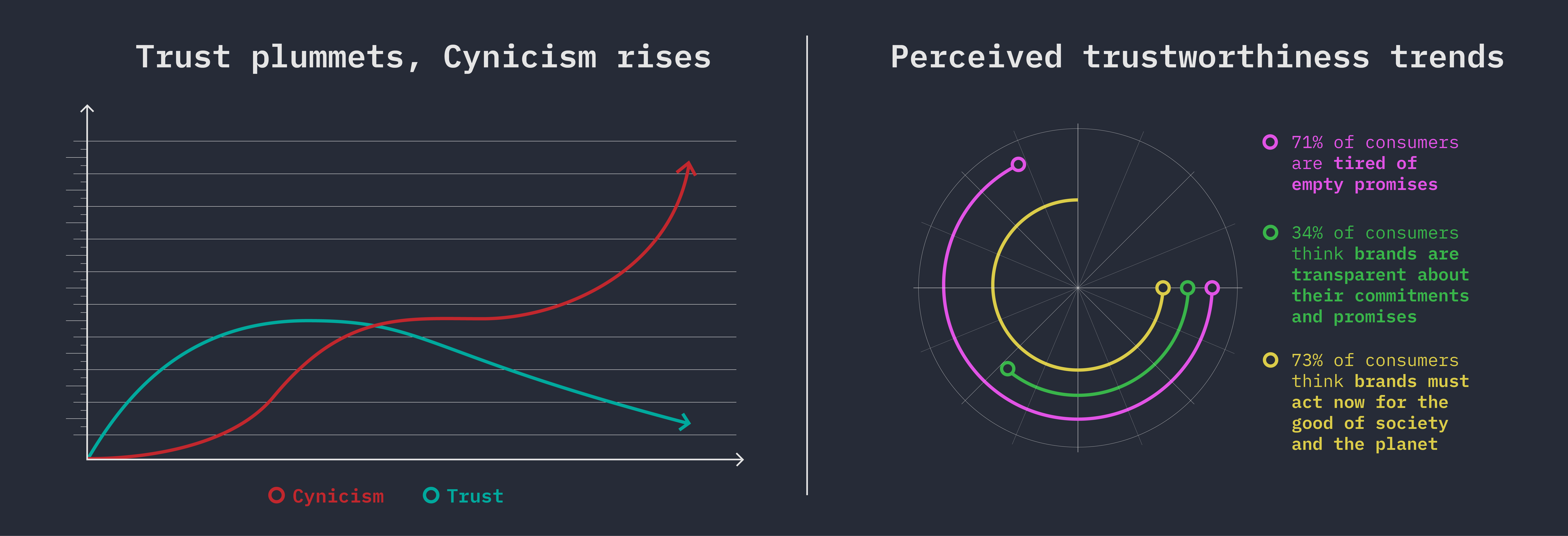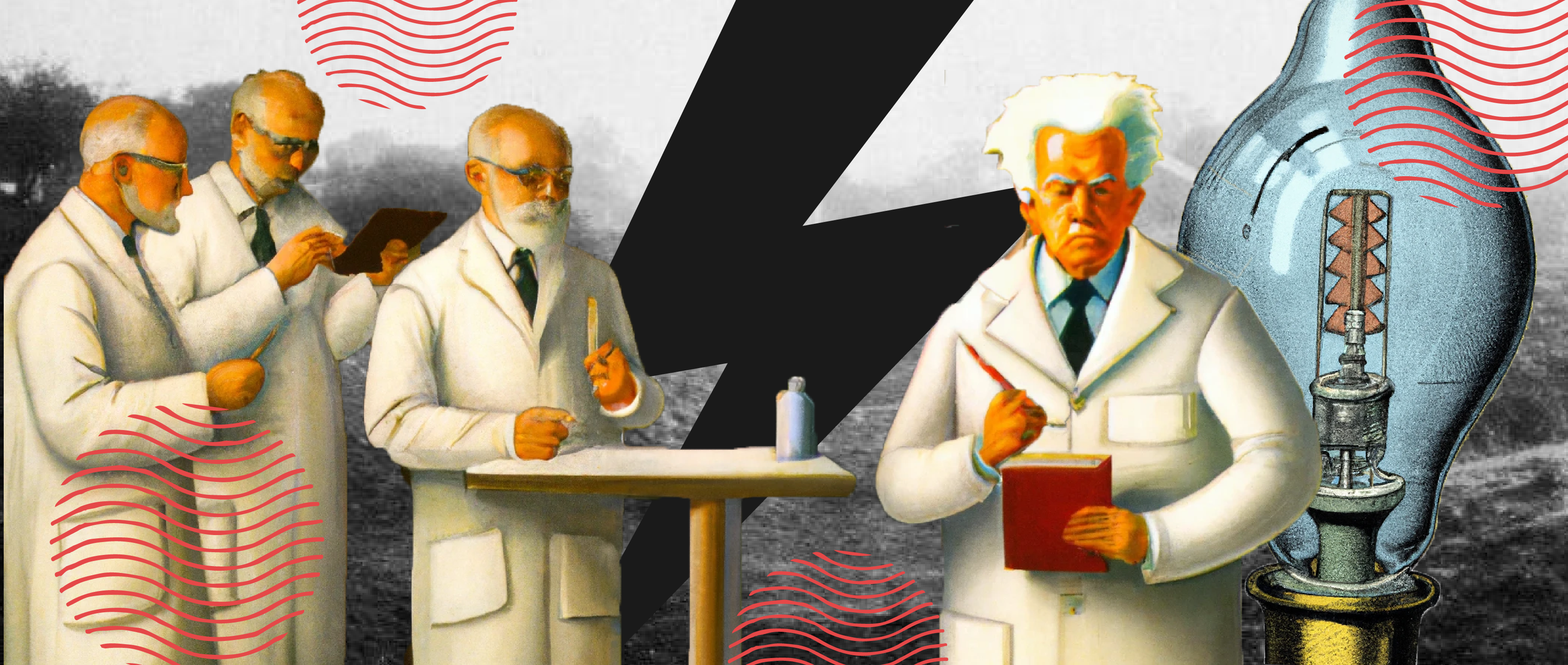
My summer as an intern at VOLTAGE
Internships. Are they still a thing? Our Project Management intern, McKenna, reflects on her summer at VOLTAGE.



Despite having greater data and access to consumers than ever before, studies show that brands are struggling to build customer trust and authenticity. How can your brand stand out and become a Real Human Brand™? We have some solutions.
In this age of social media and smart technology proliferation (alternative headline: “My Air Fryer Has An App”), brands have more opportunities and access to consumers than ever. Screens and smart devices occupy more real estate. They line our homes, transportation routes, workplaces, and even bodies, each providing a chance to create an impression or conversion on a daily basis. Below the surface, robust consumer data pours in, allowing brands to understand and plot out their customers’ every want and need, and what makes them buy or bail.
This is the easiest time ever to be a marketer, right? Hold your bluetooth-enabled 5G horses – this direct connection goes both ways.
Social media and smart technology have ushered in a new age – the “Age of Cynicism,” as the Havas Group so aptly calls it in their 2021 Meaningful Brands study. In a survey of 395,000 people from around the world, they found that brand trust is continually dropping amongst consumers, while cynicism is on the rise. In fact, their results showed that consumers only see 47% of brands as “trustworthy.” Many consumers see brands as faceless and greedy entities. The study found 71% of consumers are “tired of brands’ empty promises,” and only 34% of consumers think “companies and brands are transparent about their commitments and promises.” However, 73% think “brands must act now for the good of society and the planet.”

What’s the antidote to this cynicism and lack of trust? Authenticity and “realness.” It’s clear that consumers want to interact with brands they align with morally, ethically, and philosophically. They crave authentic interactions with human beings. While it’s debatable whether brands can be human or not (looking at you, influencers), the ways in which brands engage and interact with consumers absolutely can be.
Therein lies the paradoxical problem: how can brands leverage technology to build trust, grow authenticity, and become more human, without contributing to this growing sense of cynicism? We have a few ideas.

Storytelling is an ancient art – human beings have been spinnin’ yarns since the dawn of time. What do you think we did before all these screens kept us busy? We talked. For every Gilgamesh-level epic however, there were dozens of self-indulgent, braggadocious, and worst of all, boooooring tales told. The cave people sighed and rolled their eyes then, just as the more tech-savvy cave people now click “unsubscribe” or close the tab.
In today’s digital world, the challenge is telling authentic stories. Share the good, the bad, and the ugly. The hard-fought wins as well as the losses. Be humble, be funny. In doing this, your brand will begin to take on a personality – one which customers can relate to.
HOT TIPS
Key Takeaway: Talk about your customer more than you talk about your brand. Your customer doesn’t care about the (truly) hilarious thing that came out of the quarterly business review meeting last month. However, a heartwarming true story, presented humbly, about a customer who used your product to better their life will generate interest and shares. This shared positivity will create ripples across channels – and be a great morale booster for your internal team.

In web development, much focus is placed on pleasing the algorithms and search engines, but is your website ready for humans once they finally arrive?
Imagine your customers as climbers perched perilously on a cliff. Any slippery points could send them sliding to their demise (less dramatically put: they leave your website. *Gasp!*). For some users, it only takes one moment of friction on your site to lose them forever.
Below are five rapid tips to clear the path to purchase and embrace empathy for your customers’ experience:
Key Takeaway: Making your site human-friendly is a surefire way to build your brand’s humanity. Go figure.
A wonderful quality to find in a human being is that they’re a great listener. Shouldn’t your totally-human-and-definitely-not-a-robot brand be the same way? Communication goes two ways, and a great way to humanize your brand is to lower the walls around your communications and create avenues for your customers to give input and interact with your brand. Ironically, the way to make this happen is with technology. We’re talking social media, surveys, communities, on-site chat, and even text messaging.
Social media gives you a great opportunity. While it’s the perfect place to engage with your customers and biggest fans, it’s a great place to create them, too. To level up your listening, check out the hot tips.
HOT TIPS
Key Takeaway: Talk less, listen more. This takeaway will help you to keep your own opinions close to your chest and dig deeper into the mindset of your audience.

When done correctly, nurture marketing is a powerful channel through which to humanize your brand. One angle not utilized enough, for example, is infusing your emails and SMS messages with ~*personality*~. You’re writing to a person on the other end, so make it feel personal. If it fits your brand, this is a great opportunity to challenge your copy team to add some quirk and style to your messaging – keeping customers reading for the pure enjoyment of it.
One nice touch is to write marketing communications conversationally (more water cooler, less boardroom) and have them signed off and “sent from” your founder. Take opportunities to personalize your messages through use of the recipient’s name instead of “subscriber” or drop in a random placeholder (“Salutations, esteemed subscriber!”).
In the Age of Cynicism, many consumers are wise to the transactional nature of email and SMS. Every communication should still have a clear message and call to action, but mix things up by sending a random “thank you for subscribing” email or a quirky one-off discount just because. Even if you’re a huge brand, email marketing provides the chance to project humanity.
Looking to level up your email game? Is your brand sending these eight emails? (They should be.)
Key Takeaway: Human relationships need trust. Trust needs nurturing. Authentic, personalized email and SMS will keep the lines of human communication open.

This is the last point on the list, but one of the most important. Consumers care a ton about their world and making it a better place. The Havas Group study mentioned above found that 73% of those surveyed “believe brands must act now for the good of society and the planet” and 53% of respondents “are willing to pay more for a brand that takes a stand.”
In the Age of Cynicism, it’s clear that people want to spend their time, money, and energy with brands and products that reflect their world and have a positive impact on the causes they hold near and dear.
On the flip side, they’re also highly sensitive and aware of corporations going through the motions and BS-ing their corporate social responsibility (could a more “corporate” name be chosen?) programs. Not that the net result isn’t positive – consumers are just more keenly aware than ever and repulsed by shallow “we donated $100,000, but spent +$1,000,000 telling you about it” marketing campaigns.
The skinny here is: If your brand doesn’t have one already, find a cause that aligns with your brand and purpose. Start doing the work, whether it’s making a monthly donation or collaborating on a product and donating proceeds, and then begin telling your customers about it.
Here at VOLTAGE, we believe in being a “Force 4 Good” – 4% of our profits go to charities and causes of our clients’ choosing. It’s a fantastic way to do good that also involves and excites our clients, too.
Key Takeaway: Don’t fake it. Show that you actually care about your customer and the causes that are close to their hearts.
Bonus Points: Involve your customers! Match donations made up to a certain amount or create a social media or crowdfund campaign that gets your customers involved. You’re making the world a better place, your customers do the heavy lifting, and your brand gets closer to achieving humanity. Slam dunk win/win/win.
There’s so much to unpack and adapt as we adjust to the Age of Cynicism. The way we see it, brands have the unique opportunity to rise to the occasion and make the world a better place while lifting others up through meaningful human connection. Let’s get out there and be real.
Have you found your brand needing a human touch? [We’re humans! Let us help → ]
Speaking of robotic, the images for this post were generated using the new AI tool DALL·E. Our designer received a beta invite and we put it to the test! There are a few things we’d want it to polish up, but overall had a lot of fun with the process and found it to be efficient. Hope you enjoyed.
VOLTAGE is a digital agency specializing in eCommerce, digital brand experiences, and web apps. Get emails and insights from our team:

Internships. Are they still a thing? Our Project Management intern, McKenna, reflects on her summer at VOLTAGE.

Want to get ahead of the curve on your ecommerce digital growth goals? VOLTAGE will be your digital growth partner through the highs and lows of the race to win leads. How do we do it? By using the VOLTAGE Digital Growth Framework: We take your business goals and apply our four step process until you get the results you’ve been searching for.